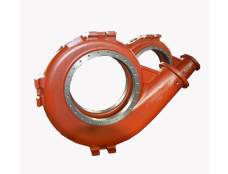+86 311 85258258
+86 311 85258258
Feb. 18, 2021
Ductile Iron
Ductile iron-- additionally described as spheroidal or nodular iron-- is actually a team of irons that exhibit high toughness, versatility, toughness, as well as elasticity due to their unique microstructure. Cast ductile iron usually contains over 3 percent carbon; it can be curved, twisted, or flawed without fracturing. Its mechanical buildings are similar to steel, and much go beyond those of conventional cast irons.
Ductile iron castings are solid metal objects that result from molten ductile iron being poured into gaps in a mold and mildew. The ductile iron ultimately cools as well as solidifies in the shape of the void it inhabits.
WHAT IS DUCTILE IRON?
Developed in 1943, ductile iron is a contemporary version of cast iron. Cast iron, as well as ductile iron, have contrasting physical buildings caused by distinctions in their microstructures.
The graphite and carbon had in cast iron happen as flakes; cast-iron exhibits favorable compressive tons capabilities, however, tensile loading above its all-natural tensile toughness can create cracks to create as well as propagate rapidly out from anxiety points within the spotted graphite microstructure. Consequently, cast iron has basically no elongation. It is a fragile material, and also as a result limited in its use in tensile and shock-loading applications.
The graphite within ductile iron takes place as spheroids, so it is sometimes described as spheroidal graphite. In a similar way, the term nodular iron comes from the truth that the carbon included in ductile iron is held in the form of blemishes. This special microstructure causes ductile iron to stand up to bending and shock loading much better than typical cast iron.
WHAT IS DUCTILE IRON MADE OF?
While ductile iron can be created from steel or iron scrap, pig iron is the primary resource of infeed for a lot of contemporary ductile iron shops. Pig iron describes the primary iron production of a blast heating system that contains over ninety percent iron.
The term "pig iron" emerged from the old-fashioned technique of casting blast furnace iron right into molds arranged in sand beds in such a way that they could be fed from a common runner. Due to the fact that the teams of molds looked like a litter of suckling pigs, the private pieces of iron were referred to as "pigs" and also the jogger was described as a sow. Modern pigs are created by continual pig casting makers.
Pig iron is used in ductile iron production as a primary source of pure iron. It uses a variety of special benefits: pig iron contains reduced residual or unsafe elements, has consistent chemistry, advertises optimum slag problems, as well as enhances procedure control by offering consistent charge homes. The need for pig iron has actually increased in the last few years as ductile iron foundries use their benefits over alternate iron sources such as iron scrap, or melting steel scrap and including carbon.
FEATURES OF DUCTILE IRON
To develop different grades of ductile iron, one should regulate the matrix framework around the graphite during the spreading procedure or through succeeding warmth treatment. The minor compositional differences between the various grades of ductile iron exist in order to create the wanted matrix (microstructures).
Ductile iron can be considered as steel with graphite spheroids dispersed throughout its matrix. The qualities of the metallic matrix in which the graphite spheroids are suspended have a substantial impact on ductile iron's properties, however, the graphite spheroids themselves do not.
There are a number of matrices discovered within ductile iron, one of the most typical being;
Ferrite-- a pure, ductile, adaptable iron with little strength. This matrix has inadequate wear resistance, yet high effect resistance and excellent machinability.
Pearlite-- a mechanical mixture of ferrite and also iron carbide (Fe3C). It is relatively tough, with moderate ductility. It has high stamina, great wear resistance, modest effect resistance, as well as great machinability.
Pearlite/Ferrite-- a structure including combination pearlite and also ferrite, and also one of the most usual matrix for industrial qualities of ductile iron.

PREVIOUS: Practical Uses For Ductile Iron
NEXT: Metal Casting